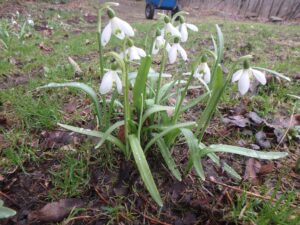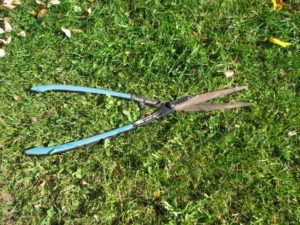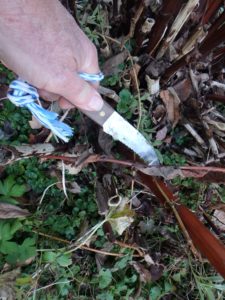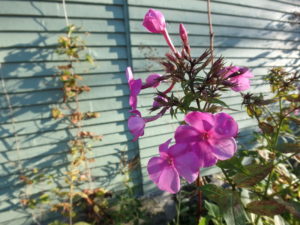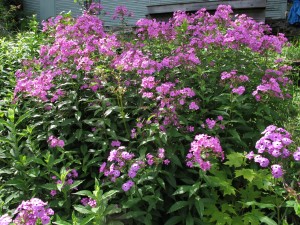Flowers Fit for a Much Loved Dog
Daphne mezereum was the registered name of my corgi, Daffy, who passed away on August 25 of this year. Born in 2006, Daffy was my constant companion who was always ready for an adventure – or especially, a meal or snack. When her back legs gave out, she figured out ways to propel herself forward with glee – ignoring the inconvenience, and trying to overcome the pain. Finally, when the pain was nearly constant, and we reluctantly called the vet.
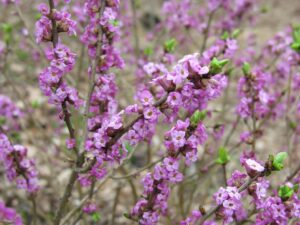 Of course I cut branches of her namesake, Daphne mezereum or February Daphne. It is a fabulous shrub that blooms in May here in Cornish Flat, displaying pinky-purple fragrant flowers in abundance. It is slow-growing, so easy to maintain. No need to do much pruning – other than stems I cut to force in a vase each year in April.
Of course I cut branches of her namesake, Daphne mezereum or February Daphne. It is a fabulous shrub that blooms in May here in Cornish Flat, displaying pinky-purple fragrant flowers in abundance. It is slow-growing, so easy to maintain. No need to do much pruning – other than stems I cut to force in a vase each year in April.I cut fresh perennial flowers for Daphne’s grave, too. Phlox have been gorgeous this year, disease-free and fragrant. Daffy is the only dog I’ve had who noticed flowers. I have a picture of her checking out a vase of tulips. But phlox is in all its glory in sunny beds, so I cut some.
Then we added some Shasta daisies, those wonderful, cheerful flowers with white petals around a central yellow button. My patch of those gets a bit bigger each year in full sun. And Mexican sunflowers (Tithonia rotundifolia), a 6-foot tall orange annual in the daisy or sunflower family. We start lots of these by seed each year, and I am always delighted by the results.
Putting the Garden to Bed
Early autumn is a great time to work in the garden, and it’s not too early to start putting your garden to bed. I can work early in the morning without layers of wool, and my hands don’t need gloves to stay warm. Too often we gardeners wait until later, when frost is on the garden, to clean up. Start now, do a little each day, and the job will not be onerous.
Start by removing anything that is ugly. Your bleeding hearts (Dicentra spectablilis) has foliage that is yellow and has collapsed. Cut it out! Peonies may have dark blotches on the leaves – a potential sign of a fungal disease called botrytis – and should be removed.
Anything that looks like it is diseased should not go in the compost pile, but in the household trash or on a burn pile for winter. Be sure to cut right to the ground when removing foliage. Yes, you have to bend down a little lower, but the close to the ground, the better. That way you will be more likely to remove any diseased portions, and it will look better in the spring.
I know many gardeners like hand pruners to remove foliage, but I find that a bit tedious. I like a serrated knife. I hold a handful of tops, and with one swipe of my knife I cut through it all. The same group of stems might take a dozen snips. I’m all for speed and efficiency when working in the garden.
Other techniques? Hedge shears will make quick work of a big clump of iris leaves. But make sure they are sharp. Modern electric hedge clippers work, too, but I have been known to cut off the cord. Be sure to plug into one of those special outlets with reset buttons (GFCI) if you using electric hedge clippers – they’ll save you from getting electrocuted!
I have one 50 foot bed that is 8 to 10 feet wide. I call it my Darwin bed, as plants compete for space. No weeding. It’s full of tall plants like Joe Pye weed, turtlehead, phlox and more (including goldenrod for the pollinators). In late October, but before snow, I will run over the entire bed with a riding lawn mower, blade all the way up, engine racing at full throttle. It works!
You may wish to leave some flowers for the birds. Nice seed pods on purple cone flowers and black-eyed Susans will please the finches in winter, and look great above a thin layer of snow. Decorative grasses will sway in the winter wind, and look good for at least a month or two. You can always clean them up in the spring, or during a winter thaw if so inclined (and wearing wool).
As you cut back your perennials you will notice some volunteer plants. Phlox is forever planting itself around my garden, as is great blue lobelia and (dis-) obedient plant. It is natural to say, “Oh, how nice, the phlox is spreading.” But do I really want more phlox? NO, if I did want more, I would have planted more. I’d really like a new color, not more of the same. So I’ll dig it up and put it at the end of the driveway in a throwaway plastic pot. “FREE” will stop traffic.
As you cut back, weed! That will require different body motions – and fewer aches and pains. You probably already know some weeds by name, and by root. Some are perennials or biennials with deep tap roots. Others have lateral roots with nodes that send up more weeds. Annual weeds pull up with little effort and have small roots – but thousands of seeds. Try not to shake out seeds from weeds that have bloomed and set seeds. They will be back to annoy you for years to come.
I bring 2 tools with me for weeding: a garden fork and a CobraHead weeder. The fork is great for deep-rooted weeds. I plunge it in or step on it to force it into hard soil, then tip it back, loosening the soil. The weed, along with the deep root, will come right out, particularly if the soil is moist.
The CobraHead weeder has a single curved tine with a widened tip. It has become an essential tool for me; it’s like a curved finger. I use it to get under a weed. It allows me to lift and loosen soil beneath a weed while I tug on the top. If there are lateral roots, I tease them out, tugging and loosening until I have the entire darn thing.
Nothing beats crawling on your hands and knees for finding weeds. You are at their level. But if it’s hard for you to get back up, maybe you’d like to sit on something, particularly if the soil is cold and wet. I sometimes use a 5-gallon pail, but have seen some nice kneeling seats designed for gardeners, and have heard nice things about them. But to each her own.
Mulching? That can be the last step of fall clean up. Finely ground bark mulch or chipped leaves can be good for keeping down weeds, but don’t use too much. And try to keep it back from the crown, or center growing area of the plant. You can ruin peony’s ability to bloom by covering it with 3 inches of bark mulch. And avoid buying bagged mulch that is “color enhanced”. It has chemicals in it.
Me? I like flower gardens that have big clumps of perennials and lots of groundcover plants to cover bare spaces. That’s what Mother Nature does. I don’t like big swaths of bark mulch, though I use some in newer beds.
So go get to work on a nice day. It will save you time in the Spring.
Read Henry’s blog posts at https://dailyuv.com/
Rainy Day Woes
It’s been rainy here in Cornish Flat. I can’t remember whether the recent bout of rain was 10 inches in 7 days or 7 inches in 10 days. But I do know that my old leather clogs appear to have grown a layer of mold that looked like the stuff that grows on phlox and lilacs, powdery mildew. Sigh. My tomatoes want some sunshine – and I do, too.
But all this rain is not all bad. Let me sing praises to the rain: First, we don’t have to water anything. Usually I have to water my vegetable transplants and seed beds. Not this year.
I like raised beds for everything but onions and celeriac (also called celery root, a wonderful substitute for celery in cooking). Those two plants need lots of water, so I usually do not plant them in raised beds because raised beds drain better and dry out quicker- which they don’t like. But when my stream overflowed, my onions suffered from the running water that ran through my garden while most other things were not affected. No matter, I just righted them and re-mulched around them.
Newly planted trees and shrubs are doing well with all this rain, too. They need an inch of water a week, and that has not been a problem this year. And I always have plants in pots waiting to go in the ground which normally have to be watered. I have a pink magnolia that I bought over a month ago that is still waiting to get planted – and I have only had to water it once.
That magnolia is a hybrid called ‘Jane’, one of eight varieties developed by the USDA in the 1950’s. I’m surprised it’s not more common in cold areas, as it is gorgeous, hardy to Zone 3 (minus 40) and has the added benefit of sporadic re-blooms in August. It is a small to medium sized tree. Others in the series include Betty, Judy and Ann and others often referred to as “the magnolia girls”. All bloom 2-4 weeks later than the early star magnolia, thus usually avoiding frost damage. I can’t wait!
On the other hand, all this rain has been heaven for slugs and snails. They like wet surfaces, and that’s about all we’ve had. What can we do about them? I always start by hand picking. My kale has suffered the most. Lower leaves have been very heavily grazed by small snails. I have gone around with a jar of soapy water, tapping the leaves to make the snails drop into the water. I also have pruned off some of the lower leaves – they were Swiss cheese-like and not contributing much to the plants.
Snails and slugs tend to avoid sharp surfaces, so sprinkling coarse sand on the soil surface should help discourage them, though it is hard to know the effect. I mean I can’t exactly interview them. (Mr. Slug, how do you feel about crawling over sand to get to the kale?”)
Slugs can be controlled with a product approved for organic gardeners. It’s called Sluggo and is iron phosphate (a naturally occurring mineral) covered with slug bait. I use it around the logs that I inoculated with spore plugs to produce Shitake mushrooms. I haven’t gotten any mushrooms yet this year – they bloom best in hot weather following a wet period. A small amount of Sluggo goes a long way and ends up being cheaper than the traditional method of putting out saucers of beer to attract and drown slugs. Which I find disgusting, anyway. I never have to deal with the slugs done in by Sluggo.
I haven’t yet done much mulching this year so there is lots of bare earth in my vegetable garden. Although that means that weeds get a “Get out of Jail Free” card, it also means that the soil dries out more quickly, which is a good thing. I use my CobraHead weeder to scratch the soil surface after rains to slice off any young weeds, but more importantly, to rough up the soil surface. A rough surface allows water to evaporate more quickly. And we need that.
The last good thing about all this rain is that big-rooted weeds pull more easily. The key is to pull them slooooowly. Gentle pressure. And if they don’t move, loosen the soil with a drain spade and try again.
So far this summer I haven’t gotten powdery mildew, that bothersome white fungus that so loves old fashioned phlox and lilacs. By August, I suppose it will be rampant. Hot wet weather makes plants more susceptible to it.
You can do something now, if you’ve had trouble with powdery mildew in past years: you can divide big clumps of phlox and other mold-prone plants. That way you will have better air circulation, allowing leaves to dry out before mold hyphae (rootlets) can penetrate the moist leaves. Even mildew-resistant cultivars will get moldy if the conditions are right.
So yes, I’m ready for sunny days. But rain does have plenty of good qualities. Let’s all try to appreciate it for the nectar it is for our plants.
Henry Homeyer can be reached at henry.homeyer@comcast.net. His Web site is www.Gardening-Guy.com.




